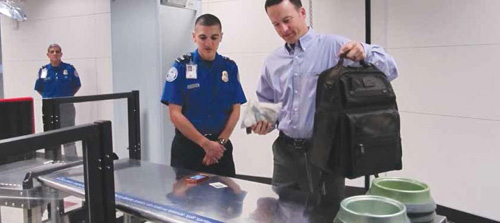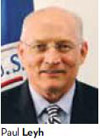TSA Pilot Programs Aim to Speed Screening Without Compromising Security

A select group of travelers began whizzing through airport security checkpoints last fall at Miami International, Dallas/Fort Worth International, Hartsfield-Jackson Atlanta International and Detroit Metropolitan as TSA launched the TSA Prev(tm) pilot program. Some travelers didn't even need to remove their shoes and belts or take out their laptops, because they were deemed "low-risk" and had voluntarily provided more information than is usually checked at screening points before their trips.
|
factsfigures Project: Expedited Screening Pilot Programs Sponsor: TSA Programs: TSA Prev, CrewPASS & Known Crewmember PrevAirports: Miami Int'l, Dallas/Fort Worth Int'l, Hartsfield-Jackson Atlanta Int'l, Detroit Metropolitan, McCarran Int'l, Los Angeles Int'l, Minneapolis-St. Paul Int'l Participating Airlines: American Airlines, Delta Air Lines Benefits: Improve & expedite screening process for passengers & airline crewmembers without compromising security |
McCarran International in Las Vegas and Los Angeles International joined the TSA pilot program in December, followed by Minneapolis-St. Paul International in January. By early February, more than 336,000 passengers had been screened through Prev lanes at various airports.
Before the end of the year, 28 additional airports are expected to become Prev locations. TSA administrator John Pistole characterizes expansion of the program as a "move away from a one-size-fits-all approach to a more intelligence-driven, risk-based" screening system.
Prev is one of several programs TSA is testing to expedite airport screening without compromising security, notes TSA spokesperson Sari Koshetz. "The gradual steps we take in the coming months and years will help maintain robust security while allowing TSA to focus its resources on travelers we know less about - ultimately easing the process for the majority of passengers, "explains Koshetz.
Acknowledging that modifications to the system cannot come soon enough for many, Koshetz notes that the ultimate proof will be in how TSA designs and implements the changes.
Pilot programs such as TSA Prev are expected to address some of the pushback from passengers and airport operators alike regarding new security screening measures implemented after 9/11.
Last year, a decade after the historic attacks, the U.S. Travel Association urged TSA to increase the efficiency of airport security checkpoints, decrease passenger wait times and begin screening passengers based on risk management methodologies. Its Blue Ribbon Panel for Aviation Security further called for improved governmental efficiency and cooperation in the execution of security responsibilities.
Taking the recommendations to heart, TSA has launched several programs designed to shorten screening times for known travelers and airline crewmembers, therefore affording screeners more time to focus on less-known travelers and intelligence-based threats to the aviation system.
Paul Leyh, TSA's general manager for commercial aviation, explains that the majority of passengers are, indeed, low-risk. Simplifying the screening process will not only improve the overall passenger experience but will "allow the TSA to focus more of its resources on those passengers who could present more of a risk."
Airport officials such as Lauren Stover, assistant aviation director for Public Safety, Security and Communications for the Miami-Dade Aviation Department, applaud TSA's efforts to  implement risk-based screening programs. "We believe they will ultimately reduce costs to the TSA, allow the TSA to focus on unknown threats rather than those travelers who can be trusted, and will actually improve aviation security."
implement risk-based screening programs. "We believe they will ultimately reduce costs to the TSA, allow the TSA to focus on unknown threats rather than those travelers who can be trusted, and will actually improve aviation security."
TSA introduced the Prev pilot to travelers via airline databases of frequent flyers. Initially, the program was rolled out at hubs of Delta Air Lines and American Airlines and offered only to premium-level frequent flyers and members of the Custom and Border Protection's Trusted Traveler Programs, which include Global Entry, SENTRI and NEXUS.
When participating travelers make a reservation, they enter their Global Entry or frequent flyer number in the "known traveler" field. That data is transmitted to Secure Flight for comparison against a watch list of travelers with known risks. Travelers who meet TSA Prev criteria receive a boarding pass with an embedded barcode indicating their status and may be directed to a lane for expedited screening. Often, they won't have to remove their shoes and belts or be asked to remove laptops and liquids from their carry-ons. Sometimes, however, they may be asked to run the full security gauntlet.
criteria receive a boarding pass with an embedded barcode indicating their status and may be directed to a lane for expedited screening. Often, they won't have to remove their shoes and belts or be asked to remove laptops and liquids from their carry-ons. Sometimes, however, they may be asked to run the full security gauntlet.
Incorporating random and unpredictable measures into the program is an important element, stresses Leyh, noting that no individual is guaranteed expedited screening. "Signing up provides them the opportunity to be considered for expedited screening," he says, "but there is no 100-percent pass."
While Leyh expects greater efficiency at security checkpoints as the number of TSA Prevparticipants grows, he notes that security lines may not necessarily move more quickly. Instead, the programs will free up TSA resources that can then be focused on passengers posing greater risks, he explains.
He does, however, predict that as the program picks up steam, more airlines and airports will be brought on board. TSA plans to expand the pilot to include Alaska Airlines, United Airlines, JetBlue Airways, US Airways, Southwest Airlines and Hawaiian Airlines as soon as the carriers are operationally ready. Additional airports are also anticipated.
SA considers various factors such as information technology infrastructure and an airport's physical layout when determining which facilities are best suited for inclusion in the TSA Prev pilot, relates Leyh. "Carriers have to be ready to accept the encoded boarding passes we are sending them and receive the messages they contain," he explains. "We hope to have most major carriers on board later this year, and we are working to expand the program to additional airports."
Crew Checks
Expediting airline crewmember screening is another major component of changes TSA is testing. Historically, pilots and flight attendants have stood in security checkpoint lines alongside roughly two million passengers that pass through the U.S. airport system every day. Beginning with pilots, TSA is beginning to test programs to get airline employees to their planes more quickly without compromising security.
"We are currently going through technical and operational testing," reports Leyh, noting that a determination about such programs should be reached sometime this year.
The Crew Personal Advanced Screening System (CrewPASS) and Known Crewmember (KCM) programs are currently available to pilots at 10 airports nationwide and operate similar to the TSA Prev program. With CrewPASS, pilots use specified lanes and present their airline badges to airport screeners. When a TSA officer enters a pilot's badge number, the badgeholder's face is displayed on a screen for the TSA officer to compare with the person standing in front of him or her.
 KCM builds on CrewPASS to verify a pilot's identity and employment status. The program adds biometric identification and requires a third form of ID and photograph that is cross-referenced with airline employee databases. "It's more about identity verification than anything else," explains Leyh. "When a pilot goes through a KCM checkpoint, it validates that this is a pilot who flies for this particular airline."
KCM builds on CrewPASS to verify a pilot's identity and employment status. The program adds biometric identification and requires a third form of ID and photograph that is cross-referenced with airline employee databases. "It's more about identity verification than anything else," explains Leyh. "When a pilot goes through a KCM checkpoint, it validates that this is a pilot who flies for this particular airline."
Just as TSA Prev passengers may still be asked to undergo more lengthy screenings, KCM and CrewPASS pilots may not always be expedited through airport security checkpoints. "We have randomness and unpredictability built into this as well," he emphasizes.
According to Koshetz, simplifying pilot screening simply makes sense. "As individuals tasked with actually flying and controlling the airplane, screening pilots for the standard prohibited items just doesn't make sense," she asserts. "On the other hand, positively confirming pilots' identities to make sure those in flight crew uniforms are who they say they are does make sense."
Stover agrees: "To apply a one-size-fits-all screening process for these individuals is a drain on limited resources. We welcome programs of this nature against the backdrop of what seems to be a very logical and reasonable solution in screening protocols for flight crew."
After the initial crewmember pilot programs are completed, TSA may add more airports to the program later this year and expand it to include flight attendants as well. Ultimately, the plan is to have all TSA-regulated airlines participate in the program by allowing them to connect to the enhanced database for screening crewmembers.
According to TSA personnel, expediting security checkpoints is just the first step in a comprehensive plan to improve the security system at U.S. airports. Other elements, both seen and unseen by the public, include intelligence gathering and analysis, explosives detection, canine teams, federal air marshals and closed-circuit television monitoring.
Koshetz expresses the agency's resolve regarding current and future changes: "We will continue to look for ways to enhance other aspects of the TSA's layered approach to security through the use of new state-of-the-art technologies, existing and proven technologies, passenger identification techniques and other developments in order to strengthen our capabilities to keep terrorists off commercial aircraft."
FREE Whitepaper
Fairbanks International Airport Baggage Transport Conveyor Enhanced With Mod Drive™ System
Airports face a host of unique industry challenges, such as meeting efficiency regulations and seeking out the best maintenance practices to reduce costs and keep operations flowing. In today’s current economic climate, any potential cost savings can go a long way.
In 2019, Alaska’s Fairbanks International Airport (FAI) sought to modernize its equipment and operations. They were dissatisfied with the performance of the gearmotors on their baggage transport conveyors and began searching for new suppliers. Regal approached FAI with a solution that could improve equipment performance and simplify maintenance, with the added benefit of energy cost savings: the Hub City® MOD Drive™ system.
This white paper discusses the hardware deployed, the test results and the annualized expectations for ROI.








